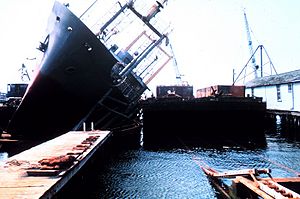NOAAS Delaware II (R 445)
| NOAA Ship Delaware II Delaware II (R 445) | |
| Career (United States) | |
|---|---|
| Name: | Delaware II |
| Builder: | South Portland Engineering, South Portland, Maine |
| Launched: | December 1967 |
| Commissioned: | October 1968 |
| Status: | Active |
| Notes: |
Served in Bureau of Commercial Fisheries 1968-1970 Has served in National Oceanic and Atmospheric Administration since 1970 |
| General characteristics | |
| Type: | Fisheries research ship |
| Tonnage: |
483 gross tons 231 net register tons |
| Displacement: | 785 tons (full load) |
| Length: | 155 ft (47 m) |
| Beam: | 30 ft 2 in (9.19 m) |
| Draft: | 14 ft 9 in (4.50 m) |
| Installed power: | 1,230 brake horsepower (0.92 megawatt) |
| Propulsion: | Two General Motors diesel engine, one shaft, 132 tons fuel |
| Speed: | 11.5 knots (sustained) |
| Range: | 6,600 nautical miles (11,112 kilometers) at 11.5 knots |
| Endurance: | 24 days |
| Boats and landing craft carried: | 1 x 18-foot (5.4 m) rigid hull inflatable boat |
| Complement: | 18 (1 licensed Master, 1 Chief Mate, 3 NOAA Corps officers, 3 licensed engineers, and 10 other crew members), plus up to 14 scientists[1] |
| Notes: | 300 kilowatts electrical power |
The NOAA Ship Delaware II (R 445) is a National Oceanic and Atmospheric Administration (NOAA) fisheries research vessel.
Delaware II was built at South Portland Engineering in South Portland, Maine. She was launched in December 1967 and commissioned in October 1968, operating under the Fish and Wildlife Service's Bureau of Commercial Fisheries. When NOAA was established in 1970, she became part of NOAA's fleet.
The hull of the ship is 155 feet (47 meters) long. The ship has a total of 32 bunk spaces. The mess room can seat 16 for meals. She carries a complement of 18—conisisting of a licensed Master, a Chief Mate, three NOAA Corps officers, three licensed engineers, and 10 other crew members—and in addition can accommodate up to 14 scientists.

The deck equipment features five winches, one boom crane, two A-frames, and a moveable gantry. This equipment gives Delaware II a lifting capacity of up to 7,000 pounds (3,170 kilograms) as well 19,680 feet (6,000 meters) of cable that can pull up to 20,000 pounds (9,070 kilograms). Each of the winches serves a specialized function ranging from trawling to hydrographic surveys.
In support of her primary mission of fishery and living marine resource research for the National Marine Fisheries Service (NMFS) division of NOAA, the ship is equipped with echo sounders and an acoustic doppler current profiler (ADCP). Additional scientific equipment includes a thermosalinograph; a conductivity, temperature, and depth profiler; three hull-mounted sea surface temperature probes and a fluorometer. She has 666 square feet (61 square meters) of laboratory space with a wet lab and a dry/chemistry lab. There is also a 201-cubic-foot (5.7-cubic-meter) walk-in freezer. An 18-foot (5.4-meter) rigid hull inflatable boat is available for utility or rescue operations.
Based at Woods Hole, Massachusetts, and operated by NOAA's Office of Marine and Aviation Operations. Delaware II conducts fishery research in support of NMFS's Northeast Fisheries Science Center's (NEFSC) Woods Hole Laboratory. She normally operates in the Gulf of Maine, on the Georges Bank, and on the continental shelf and continental slope from southern New England to Cape Hatteras, North Carolina. Typical assessment work includes groundfish assessment surveys and marine resources monitoring, assessment, and prediction (MARMAP) surveys. Research conducted from Delaware II seeks to understand the physical and biological processes that control year-class strength of key economical fish species.
See also
References
- ↑ Comnat Fleets of the World 1990/1991, p. 916, claims that the crew is 15 (6 licensed officers and 9 other crew members), plus up to 9 scientists.
External links
- "NOAA Ship Delaware II". January 10, 2006. http://www.moc.noaa.gov/de/index.html. Retrieved May 10, 2006.
- NOAA Ship Delaware II
- Prézelin, Bernard, and A. D. Baker III, eds. The Naval Institute Guide to Combat Fleets of the World 1990/1991: Their Ships, Aircraft, and Armament. Annapolis, Maryland: United States Naval Institute, 1990. ISBN 0 87021 250 8.
